

String theory. String theory was first studied in the late 1960s[3] as a theory of the strong nuclear force before being abandoned in favor of the theory of quantum chromodynamics.

Subsequently, it was realized that the very properties that made string theory unsuitable as a theory of nuclear physics made it a promising candidate for a quantum theory of gravity. Five consistent versions of string theory were developed until it was realized in the mid-1990s that they were different limits of a conjectured single 11-dimensional theory now known as M-theory.[4] Many theoretical physicists, including Stephen Hawking, Edward Witten and Juan Maldacena, believe that string theory is a step towards the correct fundamental description of nature: it accommodates a consistent combination of quantum field theory and general relativity, agrees with insights in quantum gravity (such as the holographic principle and black hole thermodynamics) and has passed many non-trivial checks of its internal consistency. Space Time Travel & Relativity Visualized. Personal and Historical Perspectives of Hans Bethe.
Quantum World. Cookies on the New Scientist website close Our website uses cookies, which are small text files that are widely used in order to make websites work more effectively.
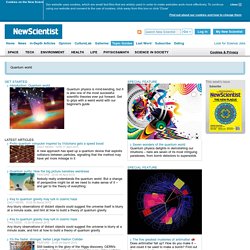
To continue using our website and consent to the use of cookies, click away from this box or click 'Close' Find out about our cookies and how to change them. Reality check: Closing the quantum loopholes - physics-math - 28 February 2011. Can the universe really be as weird as quantum theory suggests?

Ingenious experiments are coming close to settling the issue WHEN Rupert Ursin stood in the darkness at the highest point of La Palma in the Canary Islands he found it scary. "Really scary," he says. Quantum quiet - physics-math - 04 January 2001. Information encoded in peculiar quantum states is immune to a common type of noise, physicists report.
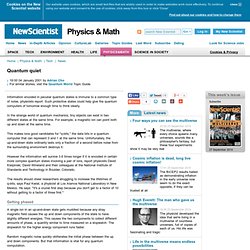
Such protective states could help give the quantum computers of tomorrow enough time to think clearly. In the strange world of quantum mechanics, tiny objects can exist in two different states at the same time. Entangle Schrödinger's cat to up its quantum weirdness - physics-math - 01 November 2012. Nothing is more adorable than a kitten playing with string, but when Schrödinger's cat becomes entangled, things get really weird.
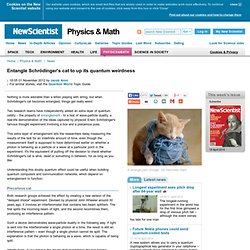
What is Quantum Physics. Quantum mechanics. Wavefunctions of the electron in a hydrogen atom at different energy levels.
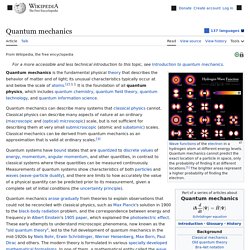
Quantum mechanics cannot predict the exact location of a particle in space, only the probability of finding it at different locations.[1] The brighter areas represent a higher probability of finding the electron. Quantum mechanics (QM; also known as quantum physics, quantum theory, the wave mechanical model, or matrix mechanics), including quantum field theory, is a fundamental theory in physics which describes nature at the smallest scales of atoms and subatomic particles.[2] Quantum mechanics gradually arose from theories to explain observations which could not be reconciled with classical physics, such as Max Planck's solution in 1900 to the black-body radiation problem, and from the correspondence between energy and frequency in Albert Einstein's 1905 paper which explained the photoelectric effect.
History[edit] In 1838, Michael Faraday discovered cathode rays. Where h is Planck's constant. Coulomb potential. Quantum mechanics. Richard Feynman on Quantum Mechanics - Part 1 - Photons: Corpusc. The Vega Science Trust - Richard Feynman - Science Videos. Paul Dirac: The unsung genius. Most people have never heard of Paul Dirac.

But, a new exhibition by Britain's Royal Society points out, it's because of him that we've got electronics. So who was he? The mathematician Mark Kac divided geniuses into two classes. Ordinary ones whose achievements others will emulate, and magicians whose inventions are so astounding that it is hard to see how any human could have imagined them. Paul Dirac was one of these magicians.
Paul Dirac. Paul Adrien Maurice Dirac OM FRS[2] (/dɪˈræk/ di-RAK; 8 August 1902 – 20 October 1984) was an English theoretical physicist who made fundamental contributions to the early development of both quantum mechanics and quantum electrodynamics.
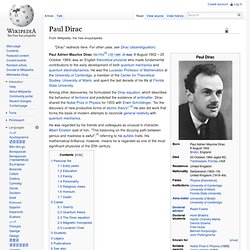
What if we could split the Higgs boson? - physics-math - 12 July 2012. Read more: " Higgsteria: Hunting the world's most wanted particle " The standard model of particle physics assumes the Higgs boson is an elementary particle.

But what if, rather like the proton, it is itself made up of particles? We know the standard model is incomplete because it cannot explain all the phenomena we observe (see " Beyond Higgs: Deviant decays hint at exotic physics "). Tweaking the model to make the Higgs a composite of quark-like particles, bound together by a new force, could solve this problem. It turns out that there is more than one way to arrange these new particles and forces to produce something akin to dark matter . Physicists propose factory to spew out Higgs particles - physics-math - 05 July 2012. Read more: "Higgsteria: Hunting the world's most wanted particle" No sooner has one mammoth accelerator delivered its first big result, than discussions begin on what should replace it.
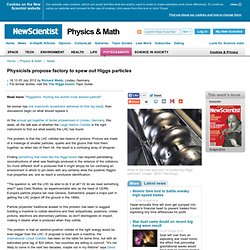
At the annual get-together of Nobel prizewinners in Lindau, Germany, this week, all the talk was of whether the Large Hadron Collider is the right instrument to find out what exactly the LHC has found. The problem is that the LHC collides two beams of protons. Protons are made of a melange of smaller particles, quarks and the gluons that hold them together, so when two of them hit, the result is a confusing array of shrapnel. Finding something that looks like the Higgs boson has required painstaking reconstructions of what was fleetingly produced in the violence of the collisions. Higgs certainty boosted by more complete analysis - physics-math - 01 August 2012. By Lisa Grossman Its discovery last month sparked a media storm but the Higgs boson is now even more of a sure thing.
ATLAS, one of the two experiments behind the original discovery, has carried out a more complete analysis that boosts the statistical significance of the Higgs signal even further. The analysis also shores up the classification of the particle as a Higgs boson – though whether this is exactly the Higgs boson predicted by the standard model of particle physics, or one with slightly different properties has yet to be nailed. On 4 July, the twin detectors at the Large Hadron Collider near Geneva, Switzerland – CMS and ATLAS – announced that they had finally found the long-sought Higgs boson, the last missing piece of the standard model and the particle credited with giving other particles mass. The Higgs wasn’t glimpsed directly: once it is created inside the detector it decays so quickly that it can only see the other particles the boson decays into.
Higgs-spotting is much easier in Flatland - physics-math - 25 July 2012. CALL them the alternative Higgs hunters. A group of researchers has glimpsed a simulated version of the elusive particle in the behaviour of a handful of atoms on a lab bench. In marked contrast to the high-energy collisions of the Large Hadron Collider (LHC) at CERN near Geneva, Switzerland, where the real Higgs boson was made, the atoms in the new work were arranged in an ultracold, flat array. The work suggests that something like the Higgs mechanism, which is thought to have given mass to elementary particles in the hot, early universe, operates in a range of physical situations.
Similar physics could even be at play in the alternate universes that pop up in some versions of string theory, if they turn out to exist. "It says a lot about the unity of physics, and how this is a deep and fundamental concept that appears in many different physical situations," says Subir Sachdev of Harvard University, who studies ultracold systems but was not involved in the new work.